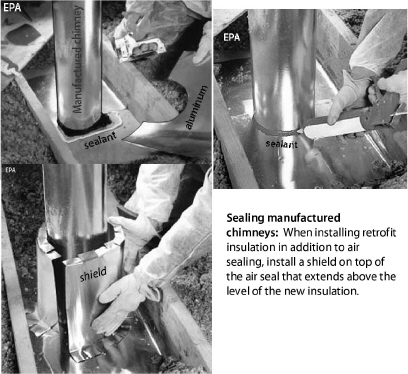
This chapter discusses air sealing and insulating attics and roofs. Whether the thermal boundary is at the attic floor or the roof, the air barrier and the insulation should be adjacent to one another and continuous at that location.
5.1 Air-Sealing Attics and Roofs
Air sealing attics and roofs may be the most important and cost effective weatherization measure and one of the most challenging. The attic or roof is a prominent location for air-leakage and moisture damage. Building fires tend to spread through large air leaks in the attic. Air-sealing can prevent these problems.
See “Material and Sealant Specs” on page 112.
5.1.1 Sealing Vertical Chases and Chimneys
|
SWS Detail: 3.0101.1 Air Sealing Holes; 3.0102.2 Sealing High-Temperature Devices |
Observe the following specifications when sealing vertical chases.
✓ Inspect the chase for damage and pest infestation. Repair and disinfect as necessary.
✓ Span the entire opening with a rigid material.
✓ Use structural supports like 2-by-4s or stronger lumber for spans more than 24 inches where the assembly may bear a person’s weight.
✓ Seal joints and seams at the perimeter with a compatible sealant.
✓ Install only noncombustible materials and sealants with an ASTM E136 listing in contact with any device producing 200 degrees F or more: for example —chimneys, light fixtures, vents, and flues.
See “Air-Barrier Materials” on page 113.
Sealing around Manufactured Chimneys
Several types of manufactured chimneys are common in residential buildings. We explain these in “Manufactured Chimneys” on page 340. Observe the required clearances listed in “Clearances to Combustibles for Common Chimneys” on page 340. Install the chimney’s air seal with an insulation shield if you’ll retrofit insulation after air sealing.
✓ Remove existing insulation from around the manufactured chimney.
✓ Cut light gauge aluminum or galvanized steel in two pieces with half-circle holes for the chimney that create small caulk-able cracks.
✓ Bed the metal in sealant and staple, nail, or screw the metal in place.
✓ Caulk around the junction of the chimney and the metal and air seal with non-combustible caulk labeled ASTM E136.
✓ Cut and assemble a metal insulation shield that creates a 3-inch space between the shield and chimney and extends above the planned level of the retrofit insulation.
✓ Move the existing insulation that you removed back into place around the insulation shield before installing the retrofit insulation.
See also "Air Sealing and Fire Containment" on page 111.


Sealing around Masonry Chimneys
Leaks around fireplace chimneys are often severe air leaks. Use this procedure to seal air leaks through the chimney chase.
✓ Cut sheet metal to fit the gap that borders the chimney with overlaps connecting to nearby attic framing lumber.
✓ Bed the sheet metal air seal in sealant, and then fasten the sheet metal to the attic framing with staples, nails, or screws.
✓ Seal the metal patch to chimney or flue with a non-combustible sealant labeled ASTM E136.
✓ Seal other gaps between the attic and the chimney chase.
✓ For large chimney chases, cover the chase opening with structural material such as plywood. Maintain clearances between the structural seal and the metal or masonry chimney as listed in “Clearances to Combustibles for Common Chimneys” on page 340.
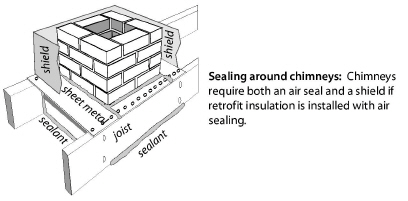
5.1.2 Air Sealing Recessed Lights
|
SWS Details: 3.0102.1 Sealing Non-Insulation Contact (IC) Recessed Light; 3.0102.2 Sealing High-Temperature Devices |
The most common type of recessed light fixture is the round can. However all recessed light fixtures are potential air leaks and air-leakage conduits. Many recessed light fixtures have safety switches that turn them off at around 150° F. Too much insulation covering the fixture or foam insulation could cause the safety switch to cycle.
Types of Recessed Can Lights
There are three kinds of recessed can lights found in buildings with regard to their need for insulation shielding. (IC means insulation contact. AT means airtight.)
1. Older cans that aren’t rated for contact with insulation, known as non-IC-rated cans.
2. IC-rated cans that may be covered with fibrous insulation but not foam insulation.
3. ICAT-rated cans that are airtight in addition to being rated for insulation contact. The tightest ICAT fixtures have pin-based CFLs or LEDs.
Options for Sealing Non-IC-Rated Fixtures
Consider these three options for air sealing recessed can lights. You can enclose the existing fixture, replace it with an ICAT recessed fixture, or retrofit it with an LED retrofit kit.
1. Build a Class I fire-resistant enclosure over the non-IC-rated fixture leaving at least 3 inches clearance from insulation on all sides and to the lid of the enclosure. Seal this enclosure to surrounding materials with foam to create an airtight assembly. The top of this fire-resistant enclosure must have an R-value of 0.5 or less. Don’t cover the top of the enclosure with insulation.
2. Replace the recessed fixture with a new ICAT fixture, and carefully seal around this airtight fixture.
3. Install an airtight LED-retrofit assembly in the existing can. This option assures that the light is energy-efficient and low heat because you replace the existing incandescent lamp holder with a cooler LED retrofit assembly.
If the non-IC rated fixture remains, replace the incandescent lamp with a compact fluorescent lamp (CFLs) or LED lamp, which operates cool and minimizes the fire hazard associated with these fixtures.
Caution: Don’t cover IC-rated or airtight IC-rated fixtures with spray foam insulation. The foam’s high R-value and continuous contact could overheat the fixture.
See also "Safety Preparations for Attic Insulation" on page 158.
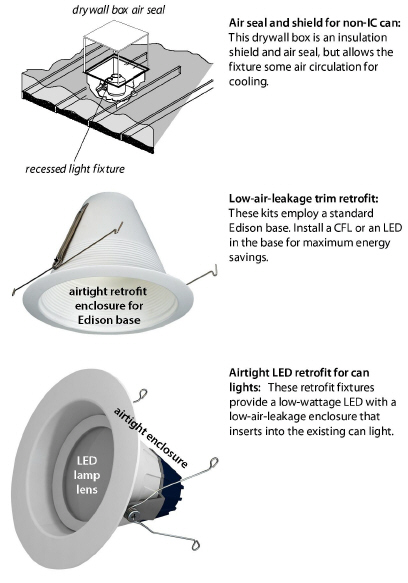
5.1.3 Sealing Stairways and Access Doors
|
SWS Details: 3.0102.11 Sealing Roof/Wall Connections; 3.0103.2 Exterior Roof Access Panels and Hatches; 3.0103.1 Access Doors and Hatches |
There are a variety of stairways, hatches, and access doors that provide access from buildings to an unconditioned attics.
The following components of these locations may need air sealing and insulation depending on whether they are at the thermal boundary.
• The risers and treads of the stairways
• The surrounding triangular walls
• Vertical or horizontal doors or hatches
• The framing and sheeting surrounding the doors or hatches
• Sloping ceilings above the stairways
Consider the following air-sealing procedures.
✓ Study the geometry of the stairway and decide where to establish the air barrier and install the insulation.
✓ Weatherstrip around doors and hatches if the door or hatch is at the thermal boundary.
✓ Air-seal and densepack the walls and underneath stair-stringers if the stairs define the thermal boundary.
✓ Seal gaps between the door frame and the framing with one-part foam, two-part foam, or caulking.
✓ If attic insulation is or will be above the level of the attic-access hole, build a dam that extends above the top of the floor joists around attic access hatch. Make the dam strong enough to support the weight of anyone entering the attic. Air seal this dam to the surrounding structure of the attic access hatch.
✓ With existing insulation dams, clear existing fibrous insulation from around dam around the hatch framing. Spray two-part foam around the perimeter to reduce heat loss through the hatch framing.
See also "Walk-Up Stairways and Doors" on page 180.
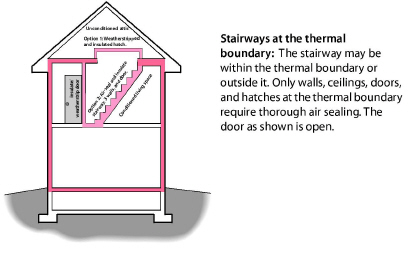
5.1.4 Sealing Porch Roof Structures
Porch roofs on older homes were often built at the framing stage or before the water resistive barrier (WRB) and siding were installed. The porch’s roof sheathing, roofing, and tongue-and-groove ceiling aren’t air barriers. The loosely fitting wall sheathing or unsheathed wall allows air into the wall cavities where it migrates into the conditioned space or convects heat into or out of the building.
Consider these options for air-sealing leaks through a porch roof.
• Remove part of the porch ceiling and install a rigid air barrier or cover the area with closed-cell spray foam.
• Dense-pack the porch-roof cavity to reduce the airflow through the porch roof and wall cavities.
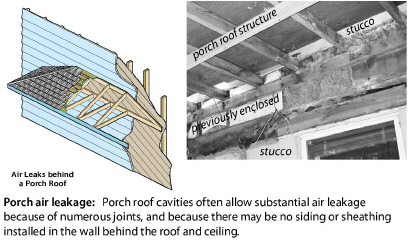
5.1.5 Removing Insulation for Attic Air Sealing
Attic air sealing is essential for successful air sealing jobs. Removing insulation from an attic for the purpose of air sealing may be worth the cost and effort. Batts and blankets can be rolled up, moved out of the way, and re-used. Loose fill insulation can be vacuumed with commercial vacuum machines available from the same suppliers that sell insulation-blowing machines. Many insulation companies own large vacuums for loose-fill insulation.
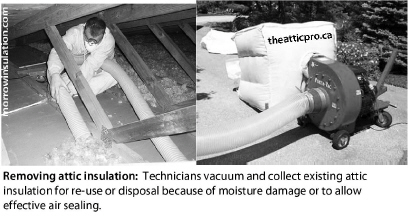
5.1.6 Sealing Joist Cavities Under Knee Walls
Floor joist cavities beneath knee walls allow air from a ventilated attic space to enter the floor cavity between stories. This is a problem of homes with a finished attic, also known as story-and-a-half homes.
Create an air seal between the knee wall and the ceiling of the space below using one of these methods.
• From the attic, install a combination of rigid foam with one-part or two-part foam sealing the perimeter.
• From the attic, stuff a fiberglass batt into the joist space and seal it with spray two-part foam from the attic.
• From the attic, install foam board on the attic side of the knee wall and continue it down to cover the joist space by cutting slots in the foam board for the joists. Seal around the joists and at the ceiling of the space below with spray foam.
• From indoors, cut the flooring back from the wall at the indoors and install the air seal and insulation under the knee wall.
5.1.7 Sealing Kitchen or Bathroom Interior Soffits
|
SWS Detail: 3.0102.9 Sealing Dropped Soffits/Bulkheads; 3.0102.11 Sealing Roof/Wall Connections |
Many modern homes have soffits above kitchen cabinets and in bathrooms. Large rectangular passages link the attic with the soffit cavity. At best, the air convects heat into or out of the conditioned space. At worst, attic air infiltrates the conditioned space through openings in the soffit or associated framing.
✓ Seal the soffit with plywood or drywall, bedded in sealant and fastened to ceiling joists and soffit framing with screws, nails or staples.
✓ Seal the patch’s perimeter thoroughly with two-part foam or caulking.
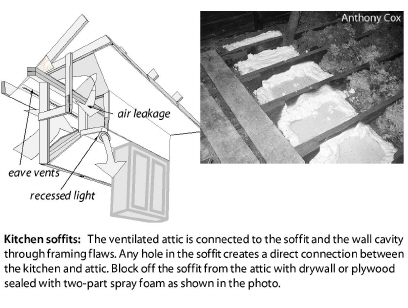
5.1.8 Sealing Two-Level Attics
|
SWS Detail: 3.0102.11 Sealing Roof/Wall Connections; 4.0201 Accessible Walls |
Split-level and tri-level homes have a particular air leakage problem related to the walls and stairways dividing the homes’ levels.
✓ Seal wall cavities below the ceiling joists from the attic with a rigid material fastened to studs and wall material.
✓ Or insert folded fiberglass batt into the wall cavity and spray with at least one inch of two-part foam to create a rigid air seal.
✓ Dense-pack the transitional wall or insulate it with fiberglass batts. Either way install an air barrier on the attic side of the wall.
✓ Seal all penetrations between both attics and conditioned areas.
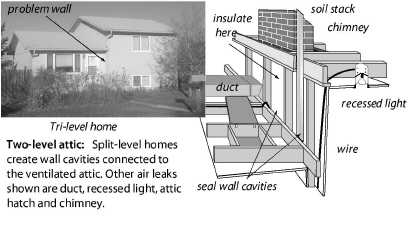
5.1.9 Sealing Dropped Ceilings
Suspended T-bar Ceilings
Suspended ceilings are seldom airtight, especially the T-bar variety. T-bar ceilings and other non-structural suspended ceilings aren’t usually a good location for an air barrier.
• The suspended-ceiling panels aren’t air barriers.
• Installers hung the ceiling room by room.
• Technicians may need access to the crawl space above the suspended ceiling in multiple locations to work on utilities installed above the ceiling.
Take down some panels of a suspended ceiling to inspect the suspended ceiling or gain access from above. If there is a plaster ceiling above a non-structural suspended ceiling, and it is weak and failing, consider these options.
✓ If you install insulation on top of existing insulation above the failing ceiling, make the original ceiling the air barrier.
✓ Reinforce the existing plaster with screws and plaster washers.
✓ Screw drywall over areas of missing plaster.
✓ Seal the ceiling’s joints and perimeter with liquid foam or other sealant.
An insulated roof deck (steel/concrete) above a non-structural suspended ceiling may be the only practical place to establish an air barrier. The perimeter walls and the wall-roof junction may be leaky and uninsulated.
✓ Air seal the roof-wall junction with SPF or other liquid-applied air sealant.
✓ Air seal the perimeter walls above the suspended ceiling and insulate them if they are exterior walls.
✓ Insulate the walls if necessary to complete the insulation and air barrier at the thermal boundary.
Strong Dropped Ceilings
Ceilings suspended using lumber or steel studs, on the other hand, may be structural enough for a lightweight person to walk on (very carefully).
✓ Seal and insulate the walls between the dropped ceiling and upper ceiling.
✓ Seal the ceiling joints, penetrations, and perimeter with spray foam or other sealant.
✓ Either insulate above the dropped ceiling or above the original ceiling.
If you decide to insulate above the original ceiling, consider making the original ceiling the air barrier unless there is too much damage or that task is too difficult.
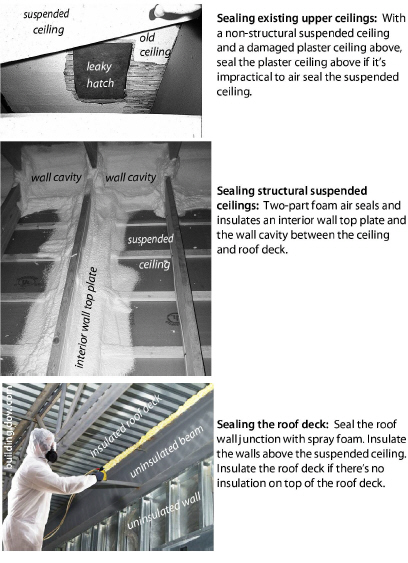
5.2 Insulating Attics and Roofs
|
SWS Detail: 4.0101 Exterior Roof Insulation; 4.0102 Interior Roof Insulation; 4.0103 Attic Floors - Unconditioned Attics; 4.0188.2 Unconditioned Attic Ventilation |
Attic and roof insulation are two of the most cost-effective energy-conservation measures.
An attic is a space under a roof where a person can walk or crawl. Buildings with flat ceilings and sloping roofs are usually insulated above the ceiling and this is attic insulation.
Buildings with sloping ceilings and flat roofs are usually insulated inside the roof cavity. Roof cavities may not be accessible for walking or crawling.
A majority of buildings have fibrous insulation in their attics or roof cavities. Fibrous insulation is the most economical insulation for attics and roof cavities. Attics and roof cavities need ventilation for drying, cooling, and to prevent ice dams. See “Fibrous Insulation Materials” on page 121.
General Insulation Specifications: Important
✓ Select fibrous insulation with a flame-spread/smoke developed or 25/450.
✓ Select foam insulation with a flame-spread/smoke-developed or 75/450.
✓ Separate all fibrous and foam insulation from living spaces or storage spaces with a thermal barrier or an ignition barrier as specified by applicable building code and the authority having jurisdiction (AHJ).
✓ Post an insulation certificate, with insulation type and number of bags installed, installed thickness, coverage area, and insulation R-value at the attic entrance. See “Insulation Receipt or Certificate” on page 120.
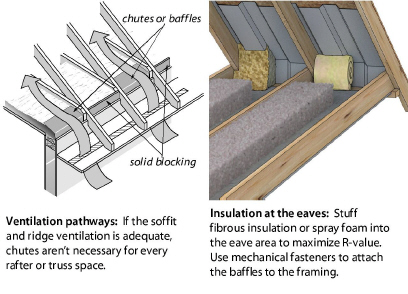
5.2.1 Preparing for Attic Insulation
Take these preparatory steps before insulating the attic.
✓ Repair roof leaks, remove other moisture sources, and repair other attic-related moisture problems before insulating attic.
✓ Remove hazardous materials, contaminated insulation, and debris from the attic, employing hazmat professionals if necessary.
✓ Shield or replace unshielded high-temperature devices —non-IC rated recessed lights, chimneys, flues, vents, for example — unless they are zero clearance devices. See “Safety Preparations for Attic Insulation” on page 158.
✓ Vent all kitchen and bath fans outdoors through appropriate roof fittings or side wall fittings. See “Fan and Duct Specifications” on page 423.
✓ Seal the perimeter of the eave area, install baffles or chutes using mechanical fasteners such as staple or screws, and install insulation against the baffle maximize the R-value at the attic’s perimeter. Evaluate attic ventilation.
✓ Before insulating the attic, seal air leaks and bypasses as described in “Air-Sealing Attics and Roofs” on page 139
✓ Verify attic air-tightness as described in “Simple Zone Pressure Testing” on page 568.
✓ Install an attic access hatch if none is present, preferably at a large gable vent on the home’s exterior. An interior attic hatch should be at least 22 inches square if possible. Insulate the hatch with rigid board foam to the maximum practical R-value. The roof’s height above the hatch may limit the thickness of insulation that you can attach to the back of the hatch door.
✓ Build an insulation dam around the attic access hatch two inches above the height of the insulation. Build the dam with rigid materials like plywood or oriented-strand board so that the dam supports the weight of a person entering or leaving the attic.
✓ If head space is very limited at an interior hatch, use fiberglass batts to dam loose fill insulation.

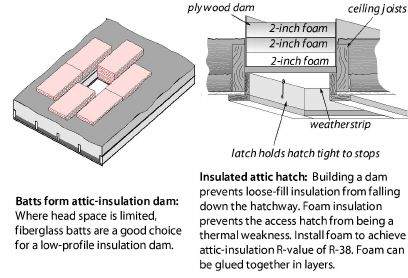
5.2.2 Safety Preparations for Attic Insulation
|
SWS Detail: Section 4 Insulation; 4.0103 Attic Floors - Unconditioned Attics; 2.0301.1 Junctions/Splices Enclosed; 2.0301.2 Knob and Tube Wiring - Isolation |
Before insulating the attic, remove electrical hazards and protect heat-producing fixtures, such as recessed light fixtures and chimneys, by installing shields. Without shields, the light fixture or chimney might ignite the insulation. Or, the insulation might cause a light fixture or chimney to become hot enough to ignite something else.
The shielding enclosure must often serve as the air-seal for the chimney or light fixture.
Protecting Electrical Wires and Enclosures
Verify that all wire splices are enclosed in UL-listed electrical enclosures with UL listed covers. All enclosures must have UL-listed covers.
See “Electrical Safety” on page 51 and “Constructing Shielding for Knob-and-Tube Wiring” on page 54.
Protecting Recessed Light Fixtures
There are three different types of recessed light fixtures and light-fan fixtures. (IC = insulation contact)
1. Non-IC-rated fixtures that must not touch insulation.
2. Type IC-rated fixtures that may be covered with fibrous insulation.
3. Type IC-AT, which are reasonably airtight (AT) and safe for contact by fibrous insulation.
Consider these options when preparing recessed light fixtures for attic insulation.
• Remove the recessed light fixture and replace it with a surface-mount fixture.
• Replace non-IC-rated fixtures with airtight IC-rated fixtures (IC-AT). You can cover these IC-AT fixtures with fibrous insulation after sealing the gap between the fixture and the surrounding materials.
• If the existing fixture is rated IC, you can seal the fixture’s enclosure to the ceiling with caulk and cover the fixture with fibrous insulation. Or you can shield the fixture with an enclosure, seal the enclosure to the ceiling with foam, and then cover the enclosure with insulation.
• Shield all existing non-IC-rated fixtures with airtight enclosures that provide 3-inch clearance above the level of the retrofitted insulation. Seal the enclosure to the ceiling with foam, and then surround the enclosure with insulation, but don’t insulate over its top.
• In cavities that are sheeted on both sides, either shield non-IC recessed lights or replace them before dense-packing the cavities.
Caution: Spray foam insulation must not cover or surround recessed light fixtures or any other heat-producing devices.
Enclosing the Non-IC Fixture that Remains
If an existing older recessed fixture that isn’t labeled IC must remain in place, do these steps.
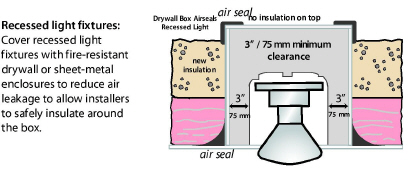
✓ Build a Class I fire-resistant enclosure over the non-IC-rated fixture leaving at least 3 inches clearance from insulation on all sides and to the lid of the enclosure. The top of this fire-resistant enclosure must have an R-value of 0.5 or less and extend 4 inches above the level of the new insulation.
✓ Notch the shields around wires.
✓ Seal the enclosure to the ceiling with foam or caulk.
✓ Don’t cover the top of the enclosure with insulation.
Protecting Chimneys
The requirements for protecting chimneys from contact with insulation vary widely from one building department to another. We know of three common approaches to insulating around chimneys, which are listed here beginning with the most restrictive.
1. Air-seal around the chimney using non-combustible material like 26 gauge galvanized steel. Seal the steel to the chimney with a high-temperature sealant.
2. After air sealing gaps, install non-combustible insulation shields around masonry chimneys and manufactured metal chimneys to keep insulation at least 3 inches away from these chimneys.
3. A clearance smaller than 3 inches may be allowed if the attic insulation is non-combustible or if the specifications of the vent material allow a clearance less than 3 inches. For example: type B gas vent has a typical minimum clearance of 1 inch and all-fuel chimneys have a typical minimum clearance of 2 inches.
4. If the insulation is non-combustible, such as blown fiberglass or rock wool, no clearance between insulation and manufactured or masonry chimneys is necessary if this option is permitted by local building officials.
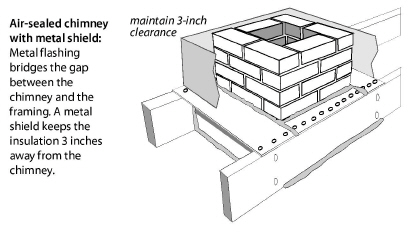
Electrical Junction Boxes
Observe these specifications during attic-insulation preparation.
1. Install covers on all electrical junction boxes that lack covers.
2. Use caulk or two-part foam to air seal electrical boxes that penetrate the ceiling (for light fixtures and fans), before blowing fibrous insulation over the boxes.
3. Flag the electrical boxes so that an electrician can find the boxes for future electrical work.
If knob-and-tube wiring is present in the attic, consider decommissioning knob and tube wiring prior to installing insulation or shielding it. See “Decommissioning Knob-and-Tube Wiring” on page 53 or “Constructing Shielding for Knob-and-Tube Wiring” on page 54
Isolating Fibrous Insulation from Occupants
If you install fibrous insulation in open cavities within living spaces, cover the insulation to protect occupants from breathing fibers. A thermal barrier, like drywall, may be necessary to establish or maintain an acceptable fire rating of the assembly. See the SWS for further guidance.
5.2.3 Blowing Attic Insulation
Install attic insulation to a cost-effective R-value, depending upon existing insulation level and climatic region. Air seal attics before installing attic insulation. Air sealing may require removing existing insulation and debris that obstruct air sealing. See “Removing Insulation for Attic Air Sealing” on page 148.
Blown insulation is usually better than batt insulation because blown insulation forms a seamless blanket. Blown fibrous attic insulation settles: cellulose settles 10% to 20% and fiberglass settles 3% to 10%. Blowing attic insulation at the highest achievable density helps minimize both settling and air circulation within the blown insulation.
Observe these specifications when blowing loose-fill attic insulation.
✓ Calculate how many bags of insulation are needed to achieve the R-value specified on the work order from the table on the bag’s label.
✓ Install insulation depth rulers: one for every 300 square feet.
✓ Maintain a high density by moving as much insulation as possible through the hose with the available air pressure. The more the insulation is packed together in the blowing hose, the greater is the insulation’s installed density.
✓ Fill the edges of the attic first, near the eaves or gable end, then fill the center.
✓ When filling a tight eaves space, push the hose out to the edge of the ceiling. Allow the insulation to fill and pack against the chute or baffle.
✓ Install insulation to a consistent depth. Level the insulation with a stick if necessary.
✓ See “Insulation Receipt or Certificate” on page 120.
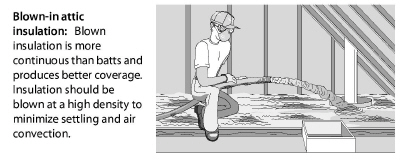
5.2.4 Closed-Cavity Attic Floors
The ceiling joists in the attic are often covered by a wood floor for storage. You may have to remove some floor boards or drill the floor sheathing to install dense-packed insulation.
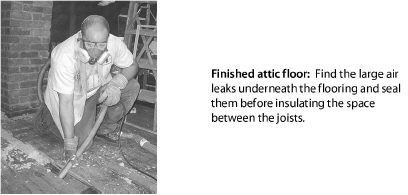
✓ Check for live knob-and-tube wiring in the cavity, and act to decommission it or protect it from burial in insulation. See “Knob-and-Tube Wiring” on page 162.
✓ Protect recessed light fixtures and other heat-producing devices in the floor cavity. See “Protecting Recessed Light Fixtures” on page 159.
✓ Thoroughly seal the floor cavity’s air leaks before blowing insulation.
✓ Then dense-pack fiberglass or cellulose insulation into the spaces between the ceiling joists.
✓ Or use spray-foam as both insulation and air seal for the attic floor.
✓ See “Insulation Receipt or Certificate” on page 120.
5.2.5 Insulating Closed Roof Cavities
|
SWS Detail: 4.0103.7 Accessible Pitched/Vaulted/Cathedralized Ceilings - Loose Fill Over; |
Many existing homes have cathedral ceilings or flat roofs that are partially filled with fibrous insulation. These roofs are often unventilated or ineffectively ventilated. The insulation job may include repair of the roof deck and installation of foam insulation over the roof deck. The IRC building code requires one of these two approaches to insulate a roof cavity.
1. Verify or provide a ventilated space of at least one inch between the roof insulation and the roof sheathing by providing soffit and ridge ventilation.
2. If no roof ventilation, then install foam roof insulation in addition to filling the cavity with insulation. Foam R-value of between R-5 and R-35 depending on climate as specified by the IRC.
Ventilated Closed Roof Cavities
To prepare for roof-cavity insulation, without existing baffles and with a ventilated space above the insulation, use this procedure.
✓ Remove either the roofing and sheathing or the interior ceiling to gain full access to the cavity.
✓ Remove recessed light fixtures and replace them with surface-mounted light fixtures. Carefully patch and air seal the openings.
✓ Install fiberglass or foam insulation to meet the IECC regional minimum roof-assembly R-value requirements.
✓ Install openings into the ventilation channel above the insulation totaling 1/150 of the roof area. If the ceiling has a Class I or II vapor retarder, the requirement is reduced to 1/300 of the roof area.
✓ In cold climates, install a Class I or II vapor retarder at the ceiling. One option is to paint an oil-based primer over the interior drywall or plaster.
✓ Repair roof leaks or install a new water-tight roof. Replace moisture-damaged sheathing as part of the roof replacement.
✓ Install an air-barrier ceiling (drywall) if the existing ceiling isn’t an adequate air barrier, for example tongue-and-groove paneling.
✓ Seal other air leaks with great care, especially at the perimeter and around ridge beams.
Un-Ventilated Closed Roof Cavities: Decisions
Many homes have cathedral ceilings, vaulted ceilings, or flat roofs that are partially or completely filled with insulation and would require major building surgery to install code-compliant roof ventilation or rooftop foam board during retrofit cavity insulation.
Dense-packing the cavities prevent most convection and moist-air infiltration, which are leading causes of moisture problems in roof cavities.
Insulators have dense-packed many cathedral roof cavities with fiberglass insulation without ventilation or foam rooftop insulation. Some experts believe that this method is acceptable. However, this method isn’t a code-compliant one and it usually requires special approval by the building department when and if the department issues a building permit.
Important Note: Dense-packing roof cavities with fiberglass insulation and without ventilation is controversial. The colder the climate, the higher the risk of problems, such as ice damming. However, dense-packing the cavities prevents most convection and moist-air infiltration, which are leading causes of moisture problems in roof cavities. Consult a knowledgeable local engineer before deciding to dense-pack a roof cavity with fiberglass. Don’t dense-pack roof cavities with cellulose because of its moisture absorption and its susceptibility to moisture damage.
Closed Roof Cavities: Preparation
To prepare for dense-packing the roof-cavity, consider the following steps.
✓ Reduce or eliminate sources of moisture in the home. See "Solutions for Moisture Problems" on page 34.
✓ Verify that the ceiling has a Class I or II vapor retarder and air barrier on the interior. If not, install a vapor retarder and air barrier.
✓ Remove recessed light fixtures and replace them with IC-AT fixtures or surface-mounted fixtures. Carefully patch and air seal the openings if you replace the recessed fixtures with surface-mounted ones.
✓ Seal other ceiling air leaks, large and small, with great care.
✓ When replacing the roof during roof-cavity insulation, install 1-to-8 inches of rigid high-density foam insulation on top of the roof deck, as required by the IRC. If you replace the roof, dense-pack the existing roof cavity as part of the process.
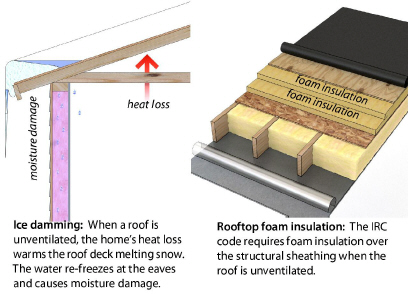
Blowing Insulation into the Closed Roof Cavity
Always use a fill tube when blowing closed roof cavities. Insert the tube into the cavity to within a foot of the end of the cavity. Access the cavity through the eaves, the roof ridge, the roof deck, or the ceiling. Consider one of these procedures.
• Drill holes in the roof deck after removing shingles or ridge roofing.
• Remove the soffit and blow insulation from the eaves.Drill and blow through a drywall ceiling.
• Carefully remove a tongue-and-groove ceiling plank and blow insulation into cavities through this slot.
See also "Insulating Mobile Home Roof Cavities" on page 521.
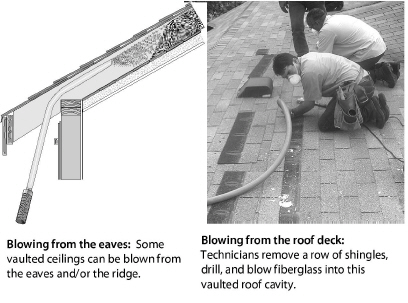
5.2.6 Exterior Rooftop Foam Insulation
Only install rooftop foam insulation over dense-packed roof cavities. A ventilation space between existing insulation and the new rooftop insulation reduces the roof assembly’s R-value. Roofers install exterior foam roof insulation when re-roofing low-sloping roofs after filling the cavities with fibrous insulation.
✓ Use high density foam board: 2 pcf for polystyrene or 3 pcf for polyisocyanurate if the roof is flat or low sloping.
✓ Flash all external penetrations according to the roofing manufacturer’s specifications.
✓ Use a cool roofing material such as white rubber or white metal to limit the foam’s temperature during intense summer sun and to minimize cooling costs.
✓ Contact a design professional to make sure the roof will drain properly after foam installation.
✓ Provide an insulation certificate, with insulation type and number of bags installed, installed thickness, coverage area, and insulation R-value at the attic entrance. See “Insulation Receipt or Certificate” on page 120.
Many foam manufacturers can taper expanded polystyrene foam, providing wedge-shaped pieces to create slope for drainage. See “Expanded Polystyrene (EPS) Foam Board” on page 131. See “Polyisocyanurate (PIC) Foam Board” on page 132.
5.2.7 Installing Fiberglass Batts in Attics
|
SWS Detail: 4.0103.3 Accessible Attic - Batt Insulation Over Existing Insulation; 4.0103.1 Accessible Attic - Batt Installation |
Follow these specifications when installing fiberglass batts in an attic. Fiberglass batts aren’t the best insulation for attics because of all their seams.
✓ When layering batts, install new layers at right angles to underlying layers if the top of the existing batts are level with or above the ceiling joist or truss bottom chord.
✓ Install un-faced fiberglass insulation whenever possible.
✓ If you must install faced batts, install them with the facing toward the heated space. Never install faced insulation over existing insulation.
✓ Cut batts carefully to ensure a tight fit against the ceiling joists and other framing.
5.2.8 Roof Deck Underside /Cathedralized Attics
|
SWS Details: 4.0102.1 SPF Roof Insulation - Unvented Roof Deck; 4.0102.2 SPF Roof Insulation - Vented Roof Deck |
A cathedralized attic has insulation attached to the bottom of the roof deck and is also called a hot roof if it isn’t ventilated. Choose to insulate the bottom of the roof deck instead of insulating the ceiling when the building owner wants to use the attic or to enclose an attic air handler and leaky ducts within the building’s thermal boundary.
Avoiding Moisture Problems
Insulating the underside of the roof deck presents a risk of moisture problems in the structural sheathing from roof leaks or condensation.
To avoid moisture condensation within the insulation or within the structural sheathing during cold weather.
• Install air-impermeable insulation such as closed-cell SPF or install a perfect air barrier and a vapor retarder to the rafters beneath the insulation.
• For additional protection against moisture, install a low-high roof-vent chute to provide ventilating air directly to the roof deck above the insulation.
• If the insulation job requires a permit, see the IRC and the AHJ for guidance on roof insulation, to prevent condensation and optimize the assembly’s thermal resistance.
Provide the client an insulation certificate, with insulation type and number of bags installed, installed thickness, coverage area, and insulation R-value. See “Insulation Receipt or Certificate” on page 120.
Unvented Spray Foam Roof-Deck Insulation
Use these procedures for spraying high-density, closed-cell foam on the underside of the roof deck.
✓ Remove any vapor retarder in the ceiling insulation at the floor of the attic.
✓ Create an airtight insulation dam at the eaves to form the roof-wall junction and to prevent spray foam from escaping into the soffit.
✓ Spray the foam to cover the entire surface of the cavity.
✓ In colder climates, install SPF to a thickness of at least a class II vapor retarder or have at least a class II vapor retarder coating or covering in direct contact with the underside of the SPF.
✓ When replacing the roof and adding insulation, install 1-to-8 inches of rigid high-density foam insulation on top of the roof deck, as required by the IRC to prevent moisture problems in a hot roof.
✓ Comply with fire safety provisions of the IRC as discussed in “Closed-Cell Spray Polyurethane Foam” on page 127.
✓ Post a dated receipt as described in“Insulation Receipt or Certificate” on page 120.
Venting a Spray-Foam Roof-Deck
If you spray-foam the bottom of the roof deck, you create a hot roof, which the IRC recognizes as sub-optimal. If you install a vented space between the roof deck and the SPF, you create a cold roof that is more durable.
✓ Install continuous ventilation path from soffit to ridge in each truss/rafter bay without any opening that SPF can penetrate or obstruct ventilation airflow.
✓ Install continuous damming at the exterior wall plate, without blocking or compromising ventilation pathway. The damming must allow for highest possible R-value but also prevent any SPF from entering venting path or exterior soffit. See “Attic Ventilation Requirements” on page 446.
Use only high-density closed-cell spray foam and not low-density open-cell spray foam for application to the bottom of a roof deck. Consult the IRC and AHJ for more guidance.

Fiberglass Roof-Deck Insulation
Insulating the rafter space with an air-permeable insulation requires an air barrier, vapor retarder, and Class I (or A) fire-rated material at the roof cavity’s lower boundary. Consider these two alternatives.
1. Install the rafter’s depth of fiberglass batts and then a material or combination of materials that constitutes an air barrier, vapor retarder, and Class I fire barrier.
2. Blow dense-packed fiberglass insulation between the roof deck using a rigid or flexible insulation restraint.
A vaulted attic is framed with a special truss that creates a sloping roof and a sloping ceiling. Access to the cavity varies from difficult to impossible.
Install insulation from either the top of the roof deck or through the ceiling. Insulation, installed at the ceiling, must have some stability to prevent gravity from pulling it downhill or wind from piling it, leaving some areas under-insulated. Damp spray fibrous insulation may serve this purpose.
Consider the following options to insulating uninsulated or partially insulated vaulted attics.
1. Insulate the ceiling with fiberglass batts. Install the batts parallel to the framing if the top of existing insulation is below the framing. Install the batts perpendicular to the framing if the top of the existing insulation is above the framing.
2. Insulate the bottom of the roof deck, as described previously for a cathedralized attic, if you remove the ceiling.
3. Insulate the ceiling with sprayed foam, damp-spray fibrous insulation, or batts from the roof with the roof sheathing removed.
4. Fill the cavity to approximately 100% with loosely blown fiberglass from indoors or through the roof. Maintain the existing vents and hope that settling or under-filling provides room for ventilation.
5. Preserve or install openings into the ventilation space above the insulation totaling 1/150 of the roof area. If the ceiling has a vapor retarder the requirement is 1/300 of the roof area.
6. Post a dated receipt as described in“Insulation Receipt or Certificate” on page 120.
5.2.10 Finished Knee-Wall Attics
The finished attics of story-and-a-half homes or Cape-Cod homes require special procedures when installing insulation. They often include five separate sections that require different air-sealing and insulating methods. Seal air leaks in all these assemblies before insulating them. If necessary, remove the planking and insulation from the side-attic floor to expose the air leaks.
Use these specifications to prepare for insulating finished attics.
✓ Seal large air leaks between conditioned and non-conditioned spaces.
✓ Inspect the structure to confirm that it has the strength to support the weight of the insulation.
✓ Insulate access hatches to the approximate R-value of the assembly through which it is located.
✓ Select fibrous insulation with a flame-spread/smoke developed or 25/450. Select foam insulation with a flame-spread/smoke developed or 75/450.
.

Attic Floor
There are a number of options for insulating the attic floor of a finished attic with knee walls. By attic floor, we mean the ceiling of the living space below with its ceiling joists and any floor sheeting installed over the joists for a storage platform.
Choose among these options.
• Install blown fibrous insulation over the ceiling, which should be an air barrier.
• Install blown fibrous insulation over existing insulation.
• Install fiberglass batts over the ceiling, which should be an air barrier.
• Install fiberglass batts over the existing insulation.
Whichever of these options that you choose, do the necessary air sealing to the attic floor before installing insulation. Also observe the preparations and safety precautions discussed in “Preparing for Attic Insulation” on page 156 and “Safety Preparations for Attic Insulation” on page 158.
Exterior Walls of Finished Attic
Insulate these walls as described in “Retrofit Closed-Cavity Wall Insulation” on page 203 or “Open-Cavity Wall Insulation” on page 207.
Collar-Beam Attic
Insulate this type of half-story attic as described in “Blowing Attic Insulation” on page 162.
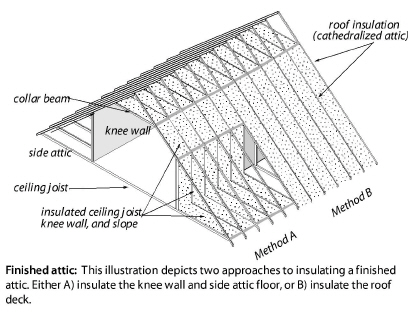
Sloped Roof
Insulate sloped roof with densepack fiberglass insulation. Install plugs of fiberglass batt, or other vapor permeable material, at the ends of this cavity to contain the blown insulation while allowing it to breathe.
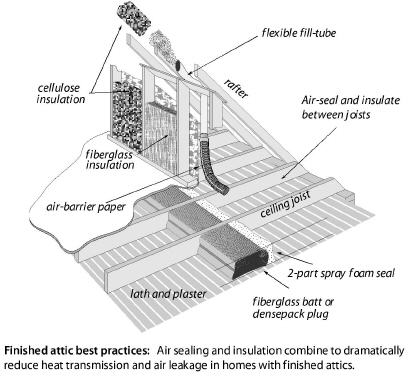
Insulate knee walls using any of these methods.
• Install un-faced fiberglass batts and cover the insulation with house wrap or rigid foam on the attic side. Prefer R-13 or R-15, 3.5-inch fiberglass batts.
• Install the house wrap, rigid foam, or another insulation restrainer first and reinforce it with wood lath. Then blow dense-packed fibrous insulation into the cavity through the insulation restrainer and patch the insulation restrainer with an airtight patch. (Cellulose: 3.5 pcf; fiberglass 2.2 pcf)
• Spray the cavities with open-cell or closed-cell polyurethane foam after gaining access to the cavities and removing dirt and debris to ensure good adhesion.
• For knee walls without framing, mechanically fasten rigid insulation to the wall’s surface and seal the seams.
• Post a dated receipt as described in“Insulation Receipt or Certificate” on page 120.
Preparation for Knee-Wall Insulation
Make whatever repairs and seal air leaks before installing the knee-wall insulation.
✓ Seal all large air leaks with structural materials.
✓ Seal all joints, penetrations, and other potential air leaks in the cavities with caulk or foam.
✓ Before installing caulk or spray foam insulation, clean dust and any other material that might interfere with the spray foam’s adhesion.
Air Sealing and Insulating under the Knee Wall
To seal and insulate under the knee wall, create an airtight and structurally strong seal in the joist spaces under the knee wall. Consider these options.
• Install sealed wood blocking between the floor joists covered with spray foam.
• Insert 2-inch-thick foam sheets and foam their perimeters with one-part or two-part foam.
• Insert a fiberglass batt into the cavity and foam its face with an inch of two-part closed-cell spray foam.
5.2.12 Access Doors in Vertical Walls
For knee-wall access doors, observe the following.
✓ Insulate knee-wall access hatches and collar-beam access hatch to the approximate R-value of the assembly that surrounds them.
✓ Weatherstrip the hatch and install a latch or other method to hold the access door closed against the weatherstrip.
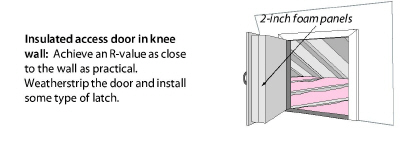
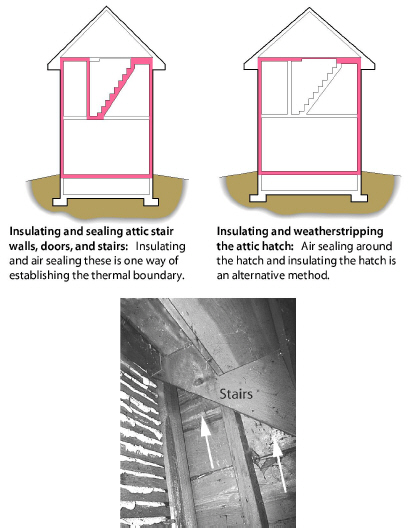
5.2.13 Walk-Up Stairways and Doors
Think carefully about how to install a continuous insulation blanket and air barrier around or over the top of an attic stairway. If you enter the attic by a stairwell and standard vertical door, use these instructions.
✓ Blow dense-pack fibrous insulation into walls of the stairwell.
✓ Install a threshold or door sweep, and weatherstrip the door.
✓ Insulate or replace the door with an insulated door if cost effective.
✓ Blow dense-packed insulation into the sloping cavity beneath the stair treads and risers.
You can also establish the thermal boundary at the ceiling level, but this requires a horizontal hatch at the top of the stairs.
When planning to insulate stairwells, investigate barriers such as fire blocking that might prevent insulation from filling cavities you want to fill. Also consider what passageways may lead to areas you don’t want to fill, such as closets.
5.2.14 Insulating & Sealing Pull-Down Attic Stairways
Pull-down attic stairways are sometimes installed above the access hatch. Building a foam-insulated box or buying a manufactured stair-and-hatchway cover are good solutions to insulating and sealing this weak point in the ceiling insulation. Install weatherstripping around the insulated box.
Educate the client on the purpose and operation of stair-and-hatchway cover, and ask them to carefully replace it when they access the attic.
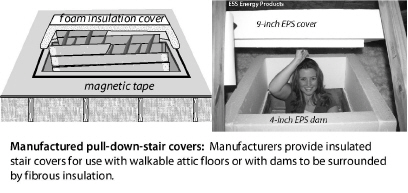
Parapet walls are a continuation of exterior walls that rise above the roof. Parapet walls are often an air-leakage and thermal bridging problem because the insulation and air barrier aren’t continuous between the exterior wall and roof.
Inspect the parapet area from both indoors and outdoors and decide how to connect the wall insulation and air barrier with the roof insulation and air barrier. Consider these two alternatives.
1. Install an air barrier and dense-pack the wall cavity of the parapet.
2. Spray foam the parapet to connect the insulation and air barrier of the exterior wall with attic or roof insulation and air barrier.
Skylights are places where the insulation and air barrier may not be continuous. Inspect the insulation and air barrier of the skylight shaft. Install insulation and air seals as necessary to make a continuous insulated and air-sealed assembly as shown in the illustration.
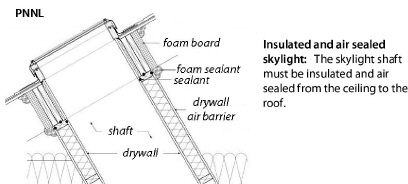
Homes with reflective roof coatings, along with at least R-19 insulation and good attic ventilation, may show two-thirds less solar heat gain than those buildings with darker roofs, little insulation, and poor ventilation.
The best cool roofs must both reflect solar heat and also effectively emit or release solar heat that accumulates in the roof assembly. The concept of emittance informs us that some materials reflect heat well but don’t release heat effectively. Their emittance prevents shiny metal materials from being efficient cool-roof materials.
Scientists at Lawrence Berkeley Laboratory created an index for comparing the coolness of roofing materials that combines both reflectance and emittance into a rating more predictive of air-conditioning energy savings. The solar reflectance index (SRI) ranges from a little less than 0 to a little more than100. High SRI numbers are better than low numbers.
Standard white asphalt shingles have an SRI of only 20 to 25 when new, and that degrades over time due to loss of white granules and dirt deposits. Darker asphalt roofs have SRIs as low as 1.0 (they absorb almost all the solar heat that strikes them). White metal roofs have good SRIs from 70 to 82.
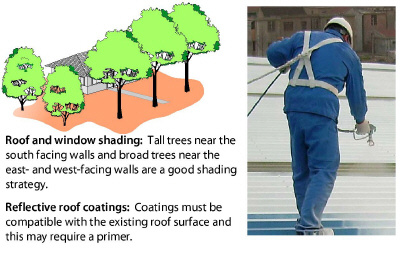
Bare galvanized steel and aluminum aren’t nearly as cool as white roofing. Those shiny metals reflect solar heat well, but they don’t emit heat effectively so they tend to heat up, resulting in SRIs in the 40s for bare galvanized steel and in the 70s for bare aluminum.
Compared to poorly ventilated roofs, good roof ventilation helps to keep attic temperatures lower. But expect less savings from improving attic ventilation compared to cool roofs and other sun-blocking measures, because radiant heat transfer —not air convection — dominates attic heat gain.
See also "Coating the Roof" on page 540.
Well-planned landscaping can reduce an unshaded building’s summer air-conditioning costs by 15% to 50%. However, poor tree siting or careless tree selection is common, so consult with landscaping experts during planning and planting.
Studies by the Lawrence Berkeley Laboratory found summer daytime air temperatures 3°F to 6°F lower in neighborhoods with mature tree canopies compared to newly developed areas with no trees.
A tree can produce daily cooling effects similar to five average-sized air conditioners running 20 hours per day. Shading and evapotranspiration — the process by which a tree releases water vapor — can reduce air temperatures as much as 9°F compared to unshaded areas.
|
Roofing type |
Reflectance |
SRI index |
|---|---|---|
|
White elastomeric coating (low slope) |
.70 to .85 |
87 to 107 |
|
White EPDM rubber membrane (low slope) |
.70 to .80 |
80 to 105 |
|
White clay tile |
.70 |
90 |
|
White rubber membrane |
.70 |
84 |
|
White metal |
.60 to .70 |
82 |
|
New aluminum metal |
.60 |
71 |
|
New galvanized steel |
.60 |
46 |
|
Colored clay tile |
.20 to .50 |
20 to 60 |
|
White asphalt shingles |
.20 to .30 |
21 to 40 |
|
Colored asphalt shingles |
.20 |
–2 to 22 |
|
Black EPDM rubber membrane (low slope) |
.06 |
–1 |
|
Higher numbers are better: a high reflectance or high SRI yields low cooling costs. An Energy Star rating (in 2008) requires an SRI of 25 or higher for steep-sloped roofs, and an SRI of 65 or higher for low-slope roofs. |
||